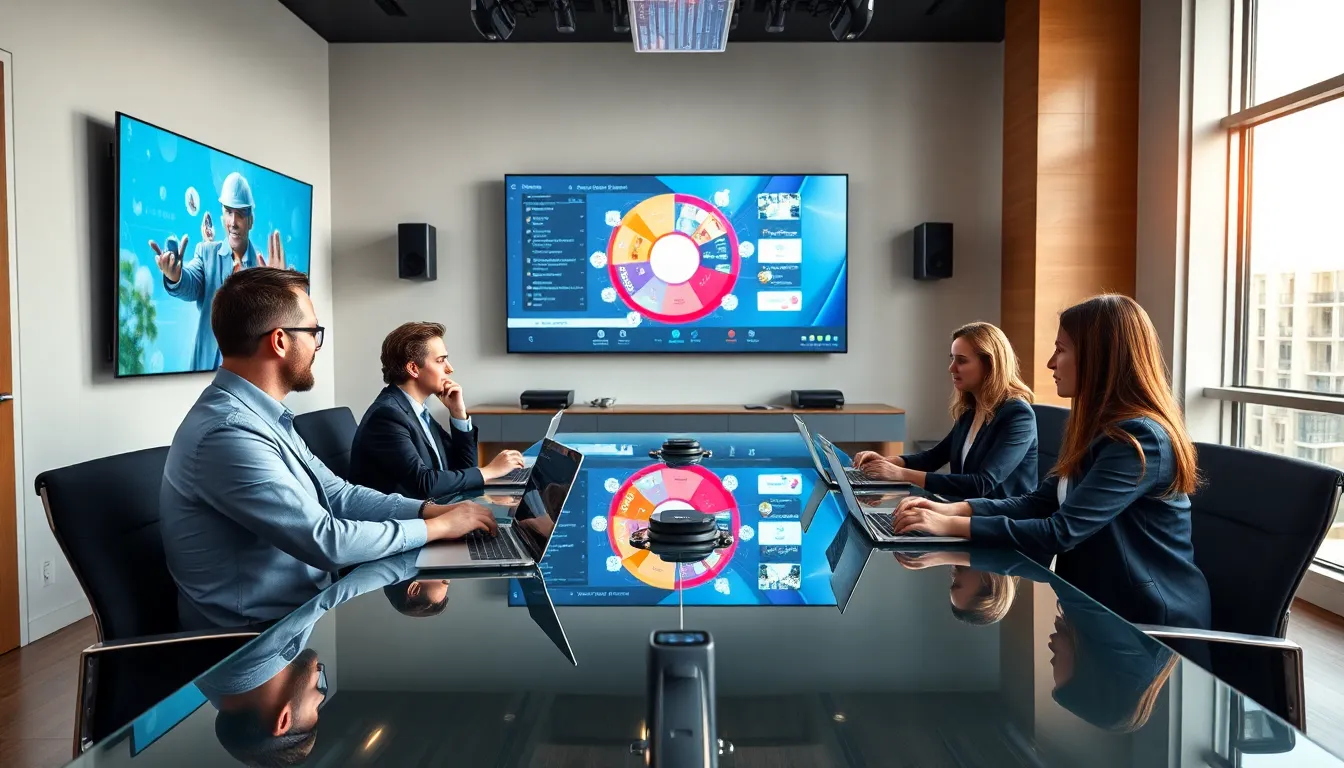In a world where “you have a presentation in 15 minutes.” can cause more anxiety than a surprise math quiz, audio visual technology comes to the rescue like a superhero in a sleek suit. Imagine a sleek projector illuminating your brilliant ideas while crisp sound waves carry your voice to every corner of the room. Welcome to the future, saving the day from the dull, the static, and the ever-so-awkward silence. This article will investigate into the intricacies of audio visual tech, showcasing how it’s changing the way we communicate, collaborate, and captivate.
Table of Contents
ToggleWhat Is Audio Visual Technology?

Audio visual technology encompasses tools and solutions combining both sound and visuals to enhance communication and interaction. This includes everything from video conferencing systems and digital signage to elaborate event setups involving lighting, sound systems, and large displays. Simply put, if it’s got a screen or makes noise, it probably falls under the umbrella of audio visual tech. This evolving field is pivotal in corporate environments, educational institutions, and entertainment venues, laying the groundwork for impactful presentations and seamless interactions.
Key Components of Audio Visual Systems
Understanding audio visual technology means knowing its essential components. The primary elements include:
1. Display Devices
Without screens, everything else is moot. Options range from projectors and flat screens to interactive whiteboards. High-definition displays bring visuals to life in stunning detail.
2. Audio Equipment
Good sound is the icing on the cake. Microphones, speakers, and sound systems are crucial for delivering clear audio, whether in a small conference room or a grand auditorium.
3. Control Systems
These systems integrate all components, making it easier to manage presentations. A touch panel might allow users to control lighting, sound, and video with a single tap.
4. Connectivity Tools
HDMI cables, wireless transmitters, and even software play roles in connecting devices. Robust connectivity ensures a glitch-free experience, which every presenter dreams of.
5. Recording and Streaming
What good is a great presentation if people can’t view it later? Recording devices and live streaming capabilities allow for distribution to broader audiences.
Applications of Audio Visual Technology
The versatility of audio visual technology opens doors to countless applications:
1. Corporate Settings
In the business realm, presentations become more effective when visuals are paired with audio. Video conferencing tools play an integral role in connecting teams and clients across the globe, making distance less of an obstacle.
2. Education
Classrooms have evolved from chalkboards to smartboards. With AV technology, educators can turn lectures into engaging visual stories, ensuring students retain critical information.
3. Entertainment
From concert arenas to cinemas, AV tech is central to delivering an immersive experience. Think about how sound plays off visuals in movies or how light displays transform a concert into a mesmerizing event.
4. Events and Conferences
Conferences thrive on audio visual setups to deliver captivating keynotes. Large screens displaying speakers and dynamic content keep attendees engaged and informed.
5. Healthcare
In hospitals, AV technologies help surgical procedures and consultations, improving patient care and collaboration among doctors.
Benefits of Audio Visual Technology
The integration of audio visual technology brings several advantages:
1. Enhanced Communication
Clarity is key. AV tech helps eliminate misunderstandings through clear visuals and sound.
2. Increased Engagement
Studies show that people remember visuals better than text alone. Captivating presentations keep audiences invested in the content.
3. Improved Collaboration
AV solutions help teamwork. Remote employees can participate as if they were in the same room, breaking down geographical barriers.
4. Accessibility
With AV technology, educational materials can be modified for accessibility, allowing everyone to engage, regardless of their needs.
5. Cost Efficiency
Investing in reliable audio visual systems can reduce communication costs long-term. Think about how much a well-placed video call saves compared to business travel.
Future Trends in Audio Visual Technology
The future of audio visual technology is bright and brimming with innovation. Below are a few trends to watch:
1. Virtual and Augmented Reality
Expect even more immersive experiences that transform how presentations are made and consumed. Imagine stepping into a three-dimensional world during a product demo.
2. Artificial Intelligence
AI could revolutionize AV systems through smart automation. Systems might learn from usage patterns, optimizing settings for the best experience without manual input.
3. Cloud-Based Solutions
With the growth of remote work, cloud-based AV systems will allow teams to collaborate seamlessly, accessing resources anytime, anywhere.
4. Interactive Displays
Interactivity isn’t just a novelty: it’s becoming essential. Touch screens and gestures will provide hands-on engagement during presentations, making discussions more collaborative.
5. Sustainability
As the world shifts towards eco-conscious practices, AV manufacturers are focusing on creating energy-efficient systems. Expect solutions that not only perform well but also minimize environmental impact.








